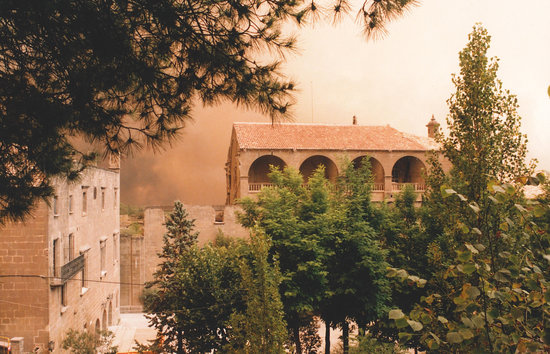Forest fires still a threat 20 years after Central Catalonia burnt
On the anniversary of the 1998 fire that destroyed 24,000 hectares, experts warn that the risk remains high

Summer in Catalonia is a time for fun and relaxation, but it is also when the countryside is most at risk from forest fires. This year is the 20th anniversary of one of the worst fires the country has ever seen, when 24,000 hectares in Central Catalonia burnt uncontrollably for three days, “surpassing by almost 20 times the fire service’s capacity of extinction,” says Marc Castellnou, head of GRAF, the firefighting unit specialised in putting out forest fires.
Even though for Castellnou the experience 20 years ago meant a “revolution” in our understanding of forest fires, the head of the GRAF unit thinks the anniversary is a good moment to “reflect” so that “people do not think that the problem is solved.” “Although the system for putting out fires is working, globally we are at the limit because climate change continues to advance and the fires are now more violent,” he adds.
At this time of year, none of us can afford to lower our guard. In fact, the hot weather of the past few weeks is reminiscent of the high temperatures and low humidity of 20 years ago. Back then, a fire began in Aguilar de Segarra, in the country of Bages, which was initially brought under control. Yet the next day, a new fire began in nearby Cardona and the two fires quickly joined up to create a 25 kilometer-long front that firefighters were often helpless to control.
For Castellnou, the 1998 fires led to an “increase in our knowledge of forest fires” and the fire service began using “knowledge, strategy and tactics” to fight them, rather than just relying on physical effort. Proof of the success of this approach for the GRAF head is that “in these past 20 years, despite worse meteorological conditions, we have seen 5,000 to 10,000-hectare fires, but nothing like the fires of 1998.”
Chance of a similar fire today is “very probable”
On the front line 20 years ago was Albert Bajona, former head of the ADF forest defence unit in the Solsonès county. Bajona recalls “that green blanket we have in Solsonès disappearing and turning black instead.” Bajona thinks the the chance of such fires happening again “is very probable,” as apart from the extreme weather conditions, “the woods are looked after much less than a few years ago, with a build up of a lot of combustible material.”
Ten years after the fire, the Barcelona high court sentenced two executives from the Fecsa-Endesa energy company to two years in prison, also forcing them to pay over 10 million euros in compensation. Sparks from a poorly maintained power line in Aguilar de Segarra were found to have started the fire. Today’s mayor of Aguilar de Segarra, Valentí Riera, says that while “you are never completely satisfied” with such court decisions, the legal action against the company helped to “ease somewhat the impact of the fire.”